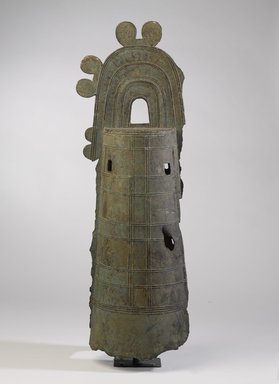
Medium: Bronze
Geograhical Locations:
Dates:100–300 C.E.
Dimensions: 34 1/2 x 11 1/2 in. (87.6 x 29.2 cm)
Collections:
Museum Location: Asian Galleries, Arts of Japan, 2nd floor
Exhibitions:
Accession Number: 67.198
Image: 67.198_PS9.jpg,
Catalogue Description: During the later stage of dōtaku development in the Yayoi period, the bells became increasingly larger, probably reflecting a change from ritual significance, to an increasing regard for size and decoration. This piece is one of the few decorative dōtaku of large size. Others include an important cultural property measuring 71.4 cm in height from the Tokyo National Museum and an excavated one from Isonokami (Imperial Household Agency Archive).There have been no dōtaku excavated from tombs, however. Most have been excavated from mountain sites overlooking places of habitation. This custom is different from the northern Kyushu tradition of burying bronze weapon-shaped objects in teh tombs of chieftainsand indicates that the dōtaku were not regarded as the property of individuals, but were rather communally owned ritual objects. This being so, the decorations on the dōtaku have been thought to tell the story of essential rituals of communities or shinwa (tales of the kami). As time passed and beliefs changed, the ritual of burying dotaku was abandoned. Rituals based on individual authority developed with the onset of the Kofun period (third-sixth century AD). Bronze in the form of a cone with flat top surmounted by an arc-shaped handle (the arc is described as kobangata, one ancient form of oval gold coins). The side view of the body is spindle-shaped. The bronze arc, which was probably used to handle the dōtaku like a bell, is in the plane of the wider diameter, and runs down the sides of the dōtaku in two vertical flanges. The body of the dōtaku is separated by five horizontal bands and one vertical (kesatasuki) on each side of the body, dividing each side of the dōtaku into 9 sections. Within the dividing bands which are formed by raised double and triple lines, are linear designs of lozenge shape. The lower band is formed by three horizontal, parallel, raised lines. Each of the top two sections is pierced by a square and is undecorated. There is also a hole on the flat top of the dōtaku. Of the six middle sections, the four upper ones are undecorated and the two lower sections contain raised triangular designs. Below the three raised lines, the section that constitutes the foot of the bell is undecorated. Rising from the rim of the arc are decorations in the form of opposed spirals and some half-spirals. Condition: Large area missing along the edge where the two main sides of the dōtaku join and including a large part of the foot-rim. The two vertical flanges along the sides of the body formed by the arc of the handle are fragmentary. One of the opposed spirals decorations rising from the rim of the arc is missing. Near the missing section on f the lower side of the Dotaku, a piece has been broken and repaired. There is also a hole in the body near this missing section with cracks and repairs above it. There is also a crack on the other side, in the vertical flange which extends down from the arc under the pair of half-spirals rising from it.